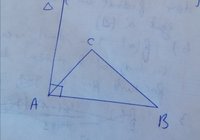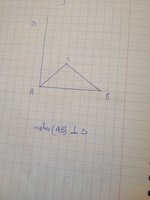Amengnichi11
New member
- Joined
- Nov 2, 2020
- Messages
- 11
The first line of your work:Hello, this is a French exercise but I translated it(sorry for the bad translation) I'm stuck in question 2)a. and i hope you guys can help me
This is the original paper
View attachment 22839
This my translation
View attachment 22840
And this is my work
View attachment 22841
View attachment 22842
Sorry for tha bad image.The first line of your work:
"ABC is not a Triangle Rectangle in A"
does not make sense to me. Can you please "rephrase" that?
Please redraw the figure - carefully - making sure that all the points are visible and all the characteristics and dimensions are included.

What happened to the rest of the points - D, D', I, etc...? Please redraw the COMPLETE picture.Sorry for tha bad image.
The first line means tha abc is not rectangle
And this is a redraw
View attachment 22843
I drawed The points D, D' and I to understand the question but as you can see the question tells you to draw them in the last part(3)b. Construire le point I, D' et l'ensemble (E))What happened to the rest of the points - D, D', I, etc...? Please redraw the COMPLETE picture.
All what you have said is correct?Let's start with a better translation; with my slight knowledge of French I could see that your first line was wrong.
I entered this into Google Translate:
Soit ABC un triangle non rectangle en A, Δ la perpendiculaire a la droite (AB) en A et D un point de Δ\{A}.On designe par (E) l'ensemble des point M du plan tels que CD.CM = 2 CA^2.1.a. Montrer qu'il existe un unique point H de la droite (CD) tel que CD.CH = 2 CA^2.b. Determiner alors l'ensemble (E).c. Justifier que l'ensemble (E) et la droite (AB) sont secants en un point D'.2. Soit I le milieu du segment [DD'].a. Montrer que CD.CD' = 2 CA.AI + CA^2.
It returns (after a couple obvious corrections):
Let ABC be a non-right triangle in A, Δ the perpendicular to the line (AB) in A and D a point in Δ \ {A}.We denote by (E) the set of points M of the plane such that CD.CM = 2 CA^2.1.a. Show that there is a unique point H on the line (CD) such that CD.CH = 2 CA^2.b. Then determine the set (E).c. Justify that the set (E) and the line (AB) are secant at a point D '.2. Let I be the midpoint of the segment [DD '].a. Show that CD.CD '= 2 CA.AI + CA^2.
Note that "rectangle" translates to "right-angled", not to "rectangle" in this case. I think it's saying that angle BAC is not a right angle (i.e. "ABC is a triangle that is not right at A").
I think CD.CM = 2 CA^2 refers to a scalar (dot) product of vectors being equal to twice the square of a length.
I think that "are secant at a point D'" means "intersect at a point D'".
Please confirm, then show your full picture neatly, as in #3.

That isn't a new, more complete picture, which is what I meant by "full". See #4.All what you have said is correct?
This the picture
I don't think you understood the question at all. I drawled D, D' and I by hand so I can understand the questionThat isn't a new, more complete picture, which is what I meant by "full". See #4.
I think we also need a clearer presentation of your work on 2a, which is what you are asking about.
